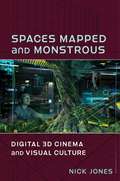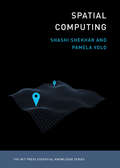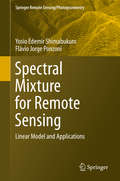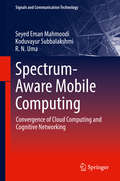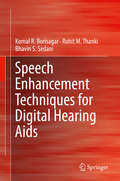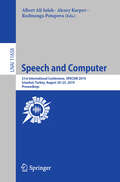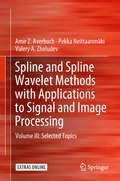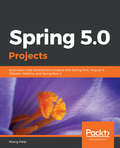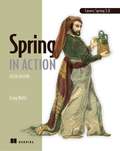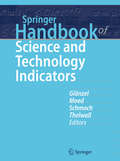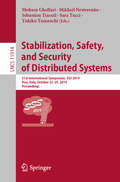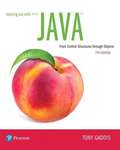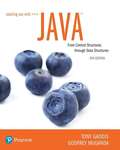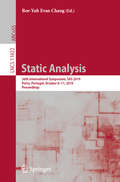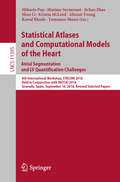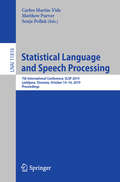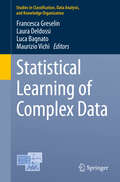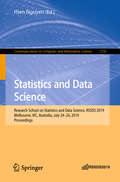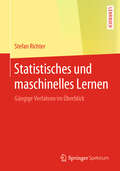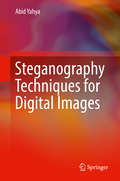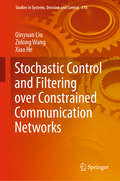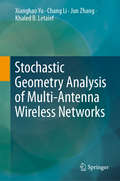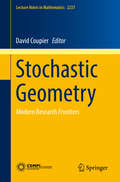- Table View
- List View
Spaces Mapped and Monstrous: Digital 3D Cinema and Visual Culture (Film and Culture Series)
by Nick JonesDigital 3D has become a core feature of the twenty-first-century visual landscape. Yet 3D cinema is a contradictory media form: producing spaces that are highly regimented and exhaustively detailed, it simultaneously relies upon distortions of vision and space that are inherently strange.Spaces Mapped and Monstrous explores the paradoxical nature of 3D cinema to offer a critical analysis of an inescapable part of contemporary culture. Considering 3D’s distinctive visual qualities and its connections to wider digital systems, Nick Jones situates the production and exhibition of 3D cinema within a web of aesthetic, technological, and historical contexts. He examines 3D’s relationship with computer interfaces, virtual reality, and digital networks as well as tracing its lineage to predigital models of visual organization. Jones emphasizes that 3D is not only a technology used in films but also a tool for producing, controlling, and distorting space within systems of surveillance, corporatization, and militarization. The book features detailed analysis of a wide range of films—including Avatar (2009), Goodbye to Language (2014), Love (2015), and Clash of the Titans (2010)—demonstrating that 3D is not merely an augmentation of 2D cinema but that it has its own unique properties. Spaces Mapped and Monstrous brings together media archaeology, digital theory, and textual analysis to provide a new account of the importance of 3D to visual culture today.
Spatial Computing (The MIT Press Essential Knowledge Series)
by Shashi Shekhar Pamela VoldAn accessible guide to the ideas and technologies underlying such applications as GPS, Google Maps, Pokémon Go, ride-sharing, driverless cars, and drone surveillance. Billions of people around the globe use various applications of spatial computing daily—by using a ride-sharing app, GPS, the e911 system, social media check-ins, even Pokémon Go. Scientists and researchers use spatial computing to track diseases, map the bottom of the oceans, chart the behavior of endangered species, and create election maps in real time. Drones and driverless cars use a variety of spatial computing technologies. Spatial computing works by understanding the physical world, knowing and communicating our relation to places in that world, and navigating through those places. It has changed our lives and infrastructures profoundly, marking a significant shift in how we make our way in the world. This volume in the MIT Essential Knowledge series explains the technologies and ideas behind spatial computing.The book offers accessible descriptions of GPS and location-based services, including the use of Wi-Fi, Bluetooth, and RFID for position determination out of satellite range; remote sensing, which uses satellite and aerial platforms to monitor such varied phenomena as global food production, the effects of climate change, and subsurface natural resources on other planets; geographic information systems (GIS), which store, analyze, and visualize spatial data; spatial databases, which store multiple forms of spatial data; and spatial statistics and spatial data science, used to analyze location-related data.
Spectral Mixture for Remote Sensing: Linear Model and Applications (Springer Remote Sensing/Photogrammetry)
by Yosio Edemir Shimabukuro Flávio Jorge PonzoniThis book explains in a didactic way the basic concepts of spectral mixing, digital numbers and orbital sensors, and then presents the linear modelling technique of spectral mixing and the generation of fractional images. In addition to presenting a theoretical basis for spectral mixing, the book provides examples of practical applications such as projects for estimating and monitoring deforested areas in the Amazon. In its seven chapters, the book offers remote sensing techniques to understand the main concepts, methods, and limitations of spectral mixing for digital image processing. Chapter 1 addresses the basic concepts of spectral mixing, while chapters 2 and 3 discuss digital numbers and orbital sensors such as MODIS and Landsat MSS. Chapter 4 details the linear spectral mixing model, and chapter 5 talks about how to use this technique to create fraction images. Chapter 6 offers remote sensing applications of fraction images in deforestation monitoring, burned-area mapping, selective logging detection, and land-use/land-cover mapping. Chapter 7 gives some concluding thoughts on spectral mixing, and considers future uses in environmental remote sensing. This book will be of interest to students, teachers, and researchers using remote sensing for Earth observation and environmental modelling.
Spectrum-Aware Mobile Computing: Convergence of Cloud Computing and Cognitive Networking (Signals and Communication Technology)
by R. N. Uma Seyed Eman Mahmoodi Koduvayur SubbalakshmiThis book presents solutions to the problems arising in two trends in mobile computing and their intersection: increased mobile traffic driven mainly by sophisticated smart phone applications; and the issue of user demand for lighter phones, which cause more battery power constrained handhelds to offload computations to resource intensive clouds (the second trend exacerbating the bandwidth crunch often experienced over wireless networks). The authors posit a new solution called spectrum aware cognitive mobile computing, which uses dynamic spectrum access and management concepts from wireless networking to offer overall optimized computation offloading and scheduling solutions that achieve optimal trade-offs between the mobile device and wireless resources. They show how in order to allow these competing goals to meet in the middle, and to meet the promise of 5G mobile computing, it is essential to consider mobile offloading holistically, from end to end and use the power of multi-radio access technologies that have been recently developed. Technologies covered in this book have applications to mobile computing, edge computing, fog computing, vehicular communications, mobile healthcare, mobile application developments such as augmented reality, and virtual reality.
Speech Enhancement Techniques for Digital Hearing Aids
by Rohit M. Thanki Komal R. Borisagar Bhavin S. SedaniThis book provides various speech enhancement algorithms for digital hearing aids. It covers information on noise signals extracted from silences of speech signal. The description of the algorithm used for this purpose is also provided. Different types of adaptive filters such as Least Mean Squares (LMS), Normalized LMS (NLMS) and Recursive Lease Squares (RLS) are described for noise reduction in the speech signals. Different types of noises are taken to generate noisy speech signals, and therefore information on various noises signals is provided. The comparative performance of various adaptive filters for noise reduction in speech signals is also described. In addition, the book provides a speech enhancement technique using adaptive filtering and necessary frequency strength enhancement using wavelet transform as per the requirement of audiogram for digital hearing aids.Presents speech enhancement techniques for improving performance of digital hearing aids;Covers various types of adaptive filters and their advantages and limitations;Provides a hybrid speech enhancement technique using wavelet transform and adaptive filters.
Speech and Computer: 21st International Conference, SPECOM 2019, Istanbul, Turkey, August 20–25, 2019, Proceedings (Lecture Notes in Computer Science #11658)
by Albert Ali Salah Rodmonga Potapova Alexey KarpovThis book constitutes the proceedings of the 21st International Conference on Speech and Computer, SPECOM 2019, held in Istanbul, Turkey, in August 2019.The 57 papers presented were carefully reviewed and selected from 86 submissions. The papers present current research in the area of computer speech processing including audio signal processing, automatic speech recognition, speaker recognition, computational paralinguistics, speech synthesis, sign language and multimodal processing, and speech and language resources.
Spline and Spline Wavelet Methods with Applications to Signal and Image Processing: Volume III: Selected Topics
by Pekka Neittaanmäki Amir Z. Averbuch Valery A. ZheludevThis book provides a practical guide, complete with accompanying Matlab software, to many different types of polynomial and discrete splines and spline-based wavelets, multiwavelets and wavelet frames in signal and image processing applications. In self-contained form, it briefly outlines a broad range of polynomial and discrete splines with equidistant nodes and their signal-processing-relevant properties. In particular, interpolating, smoothing, and shift-orthogonal splines are presented.
Spring 5.0 Blueprints
by Nilang PatelThis book is for competent Spring developers who wish to understand how to develop complex yet flexible applications with Spring. You must have a good knowledge of Java programming and be familiar with the basics of Spring.
Spring in Action
by Craig WallsSummarySpring in Action, 5th Edition is the fully updated revision of Manning's bestselling Spring in Action. This new edition includes all Spring 5.0 updates, along with new examples on reactive programming, Spring WebFlux, and microservices. You'll also find the latest Spring best practices, including Spring Boot for application setup and configuration.Purchase of the print book includes a free eBook in PDF, Kindle, and ePub formats from Manning Publications.About the TechnologySpring Framework makes life easier for Java developers. New features in Spring 5 bring its productivity-focused approach to microservices, reactive development, and other modern application designs. With Spring Boot now fully integrated, you can start even complex projects with minimal configuration code. And the upgraded WebFlux framework supports reactive apps right out of the box!About the BookSpring in Action, 5th Edition guides you through Spring's core features, explained in Craig Walls' famously clear style. You'll roll up your sleeves and build a secure database-backed web app step by step. Along the way, you'll explore reactive programming, microservices, service discovery, RESTful APIs, deployment, and expert best practices. Whether you're just discovering Spring or leveling up to Spring 5.0, this Manning classic is your ticket!What's insideBuilding reactive applicationsSpring MVC for web apps and RESTful web servicesSecuring applications with Spring SecurityCovers Spring 5.0Over 100,000 copies sold!About the ReaderFor intermediate Java developers.About the AuthorCraig Walls is a principal software engineer at Pivotal, a popular author, an enthusiastic supporter of Spring Framework, and a frequent conference speaker.Table of ContentsPART 1 - FOUNDATIONAL SPRING Getting started with Spring Developing web applications Working with data Securing Spring Working with configuration properties PART 2 - INTEGRATED SPRINGCreating REST services Consuming REST services Sending messages asynchronously Integrating Spring PART 3 - REACTIVE SPRING Introducing Reactor Developing reactive APIs Persisting data reactivelyPART 4 CLOUD-NATIVE SPRINGDiscovering services Managing configuration Handling failure and latency PART 5 - DEPLOYED SPRING Working with Spring Boot Actuator Administering Spring Monitoring Spring with JMX Deploying Spring
Springer Handbook of Science and Technology Indicators (Springer Handbooks)
by Ulrich Schmoch Henk F. Moed Mike Thelwall Wolfgang GlänzelThis handbook presents the state of the art of quantitative methods and models to understand and assess the science and technology system. Focusing on various aspects of the development and application of indicators derived from data on scholarly publications, patents and electronic communications, the individual chapters, written by leading experts, discuss theoretical and methodological issues, illustrate applications, highlight their policy context and relevance, and point to future research directions.A substantial portion of the book is dedicated to detailed descriptions and analyses of data sources, presenting both traditional and advanced approaches. It addresses the main bibliographic metrics and indexes, such as the journal impact factor and the h-index, as well as altmetric and webometric indicators and science mapping techniques on different levels of aggregation and in the context of their value for the assessment of research performance as well as their impact on research policy and society. It also presents and critically discusses various national research evaluation systems.Complementing the sections reflecting on the science system, the technology section includes multiple chapters that explain different aspects of patent statistics, patent classification and database search methods to retrieve patent-related information. In addition, it examines the relevance of trademarks and standards as additional technological indicators.The Springer Handbook of Science and Technology Indicators is an invaluable resource for practitioners, scientists and policy makers wanting a systematic and thorough analysis of the potential and limitations of the various approaches to assess research and research performance.
Stabilization, Safety, and Security of Distributed Systems: 21st International Symposium, SSS 2019, Pisa, Italy, October 22–25, 2019, Proceedings (Lecture Notes in Computer Science #11914)
by Mohsen Ghaffari Mikhail Nesterenko Sébastien Tixeuil Sara Tucci Yukiko YamauchiThis book constitutes the refereed proceedings of the 21st International Symposium on Stabilization, Safety, and Security of Distributed Systems, SSS 2019, held in Pisa, Italy, in October 2019.The 21 full papers presented were carefully reviewed and selected from 45 submissions. The papers deal with the design and development of distributed systems with a focus on systems that are able to provide guarantees on their structure, performance, and/or security in the face of an adverse operational environment.
Stable Mutations for Evolutionary Algorithms (Studies in Computational Intelligence #797)
by Andrzej ObuchowiczThis book presents a set of theoretical and experimental results that describe the features of the wide family of α-stable distributions (the normal distribution also belongs to this class) and their various applications in the mutation operator of evolutionary algorithms based on real-number representation of the individuals, and, above all, equip these algorithms with features that enrich their effectiveness in solving multi-modal, multi-dimensional global optimization problems. The overall conclusion of the research presented is that the appropriate choice of probabilistic model of the mutation operator for an optimization problem is crucial. Mutation is one of the most important operations in stochastic global optimization algorithms in the n-dimensional real space. It determines the method of search space exploration and exploitation. Most applications of these algorithms employ the normal mutation as a mutation operator. This choice is justified by the central limit theorem but is associated with a set of important limitations. Application of α-stable distributions allows more flexible evolutionary models to be obtained than those with the normal distribution. The book presents theoretical analysis and simulation experiments, which were selected and constructed to expose the most important features of the examined mutation techniques based on α-stable distributions. It allows readers to develop a deeper understanding of evolutionary processes with stable mutations and encourages them to apply these techniques to real-world engineering problems.
Star Wars: Knights of the Old Republic (Boss Fight Books)
by Alex KaneSet an even longer time ago in a galaxy far, far away, BioWare's 2003 Star Wars: Knights of the Old Republic wowed players with its compelling characters, lightsaber customization, complex morality choices, and one of the greatest plot twists in both video game and Star Wars history. But even for veteran studios like LucasArts and BioWare, the responsibility of making both a great game and a lasting contribution to the Star Wars canon was no easy task. Featuring extensive new interviews with a host of KotOR's producers, writers, designers, and actors, journalist Alex Kane weaves together an epic oral history of this classic game, from its roots in tabletop role-playing and comic books, to its continued influence on big-screen Star Wars films. Whether you align with the light or the dark side, you're invited to dive into this in-depth journey through one of the most beloved Star Wars titles of all time.
Starting Out With Java: From Control Structures Through Objects (What's New In Computer Science Ser.)
by Tony GaddisIn Starting Out with Java: From Control Structures through Objects , Gaddis covers procedural programming-control structures and methods-before introducing object-oriented programming. As with all Gaddis texts, clear and easy-to-read code listings, concise and practical real-world examples, and an abundance of exercises appear in every chapter.
Starting Out with Java: From Control Structures through Data Structures (What's New in Computer Science)
by Tony Gaddis Godfrey MugandaProvide a step-by-step introduction to programming in Java Starting Out with Java: From Control Structures through Data Structures provides a step-by-step introduction to programming in Java. This text is designed to be used in a 2 or 3 semester sequence and covers everything from the fundamentals of Java programming to algorithms and data structures. As with all Gaddis texts, every chapter contains clear and easy-to-read code listings, concise and practical real-world examples, and an abundance of exercises. With the 4th Edition, JavaFX has replaced Swing as the standard GUI library for Java in chapters that focus on GUI development. The Swing and Applet material from the previous edition is available online.
Static Analysis: 26th International Symposium, SAS 2019, Porto, Portugal, October 8–11, 2019, Proceedings (Lecture Notes in Computer Science #11822)
by Bor-Yuh Evan ChangThis book constitutes the refereed proceedings of the 26th International Symposium on Static Analysis, SAS 2019, held in Porto, Portugal, in October 2019. The 20 regular papers presented in this book were carefully reviewed and selected from 50 submissions. The papers are grouped in topical sections on pointers and dataflow; languages and decidability; numerical; trends: assuring machine learning; synthesis and security; and temporal properties and termination.
Statistical Atlases and Computational Models of the Heart. Atrial Segmentation and LV Quantification Challenges: 9th International Workshop, STACOM 2018, Held in Conjunction with MICCAI 2018, Granada, Spain, September 16, 2018, Revised Selected Papers (Lecture Notes in Computer Science #11395)
by Shuo Li Tommaso Mansi Mihaela Pop Kawal Rhode Maxime Sermesant Alistair Young Kristin McLeod Jichao ZhaoThis book constitutes the thoroughly refereed post-workshop proceedings of the 9th International Workshop on Statistical Atlases and Computational Models of the Heart: Atrial Segmentation and LV Quantification Challenges, STACOM 2018, held in conjunction with MICCAI 2018, in Granada, Spain, in September 2018. The 52 revised full workshop papers were carefully reviewed and selected from 60 submissions. The topics of the workshop included: cardiac imaging and image processing, machine learning applied to cardiac imaging and image analysis, atlas construction, statistical modelling of cardiac function across different patient populations, cardiac computational physiology, model customization, atlas based functional analysis, ontological schemata for data and results, integrated functional and structural analyses, as well as the pre-clinical and clinical applicability of these methods.
Statistical Language and Speech Processing: 7th International Conference, SLSP 2019, Ljubljana, Slovenia, October 14–16, 2019, Proceedings (Lecture Notes in Computer Science #11816)
by Carlos Martín-Vide Matthew Purver Senja PollakThis book constitutes the proceedings of the 7th International Conference on Statistical Language and Speech Processing, SLSP 2019, held in Ljubljana, Slovenia, in October 2019. The 25 full papers presented together with one invited paper in this volume were carefully reviewed and selected from 48 submissions. They were organized in topical sections named: Dialogue and Spoken Language Understanding; Language Analysis and Generation; Speech Analysis and Synthesis; Speech Recognition; Text Analysis and Classification.
Statistical Learning of Complex Data (Studies in Classification, Data Analysis, and Knowledge Organization)
by Maurizio Vichi Francesca Greselin Laura Deldossi Luca BagnatoThis book of peer-reviewed contributions presents the latest findings in classification, statistical learning, data analysis and related areas, including supervised and unsupervised classification, clustering, statistical analysis of mixed-type data, big data analysis, statistical modeling, graphical models and social networks. It covers both methodological aspects as well as applications to a wide range of fields such as economics, architecture, medicine, data management, consumer behavior and the gender gap. In addition, it describes the basic features of the software behind the data analysis results, and provides links to the corresponding codes and data sets where necessary. This book is intended for researchers and practitioners who are interested in the latest developments and applications in the field of data analysis and classification. It gathers selected and peer-reviewed contributions presented at the 11th Scientific Meeting of the Classification and Data Analysis Group of the Italian Statistical Society (CLADAG 2017), held in Milan, Italy, on September 13–15, 2017.
Statistics and Data Science: Research School on Statistics and Data Science, RSSDS 2019, Melbourne, VIC, Australia, July 24–26, 2019, Proceedings (Communications in Computer and Information Science #1150)
by Hien NguyenThis book constitutes the proceedings of the Research School on Statistics and Data Science, RSSDS 2019, held in Melbourne, VIC, Australia, in July 2019. The 11 papers presented in this book were carefully reviewed and selected from 23 submissions. The volume also contains 7 invited talks. The workshop brought together academics, researchers, and industry practitioners of statistics and data science, to discuss numerous advances in the disciplines and their impact on the sciences and society. The topics covered are data analysis, data science, data mining, data visualization, bioinformatics, machine learning, neural networks, statistics, and probability.
Statistisches und maschinelles Lernen: Gängige Verfahren im Überblick
by Stefan RichterDieses Buch verschafft Ihnen einen Überblick über einige der bekanntesten Verfahren des maschinellen Lernens aus der Perspektive der mathematischen Statistik. Nach der Lektüre kennen Sie die jeweils gestellten Forderungen an die Daten sowie deren Vor- und Nachteile und sind daher in der Lage, für ein gegebenes Problem ein geeignetes Verfahren vorzuschlagen. Beweise werden nur dort ausführlich dargestellt oder skizziert, wo sie einen didaktischen Mehrwert bieten – ansonsten wird auf die entsprechenden Fachartikel verwiesen. Für die praktische Anwendung ist ein genaueres Studium des jeweiligen Verfahrens und der entsprechenden Fachliteratur nötig, zu der Sie auf Basis dieses Buchs aber schnell Zugang finden. Das Buch richtet sich an Studierende der Mathematik höheren Semesters, die bereits Vorkenntnisse in Wahrscheinlichkeitstheorie besitzen. Behandelt werden sowohl Methoden des Supervised Learning und Reinforcement Learning als auch des Unsupervised Learning. Der Umfang entspricht einer einsemestrigen vierstündigen Vorlesung. Die einzelnen Kapitel sind weitestgehend unabhängig voneinander lesbar, am Ende jedes Kapitels kann das erworbene Wissen anhand von Übungsaufgaben und durch Implementierung der Verfahren überprüft werden. Quelltexte in der Programmiersprache R stehen auf der Springer-Produktseite zum Buch zur Verfügung.
Steganography Techniques for Digital Images
by Abid YahyaThis book covers newly developed and novel Steganography techniques and algorithms. The book outlines techniques to provide security to a variety of applications using Steganography, with the goal of both hindering an adversary from decoding a hidden message, and also preventing an adversary from suspecting the existence of covert communications. The book looks into applying these newly designed and improved algorithms to provide a new and efficient Steganographic system, called Characteristic Region-Based Image Steganography (CR-BIS). The algorithms combine both the robustness of the Speeded-Up Robust Features technique (SURF) and Discrete Wavelet Transform (DWT) to achieve characteristic region Steganography synchronization. The book also touches on how to avoid hiding data in the whole image by dynamically selecting characteristic regions for the process of embedding. Applies and discusses innovative techniques for hiding text in a digital image file or even using it as a key to the encryption;Provides a variety of methods to achieve characteristic region Steganography synchronization;Shows how Steganography improves upon cryptography by using obscurity features.
Stochastic Control and Filtering over Constrained Communication Networks (Studies in Systems, Decision and Control #178)
by Zidong Wang Qinyuan Liu Xiao HeStochastic Control and Filtering over Constrained Communication Networks presents up-to-date research developments and novel methodologies on stochastic control and filtering for networked systems under constrained communication networks. It provides a framework of optimal controller/filter design, resilient filter design, stability and performance analysis for the systems considered, subject to various kinds of communication constraints, including signal-to-noise constraints, bandwidth constraints, and packet drops. Several techniques are employed to develop the controllers and filters desired, including:recursive Riccati equations;matrix decomposition;optimal estimation theory; andmathematical optimization methods.Readers will benefit from the book’s new concepts, models and methodologies that have practical significance in control engineering and signal processing. Stochastic Control and Filtering over Constrained Communication Networks is a practical research reference for engineers dealing with networked control and filtering problems. It is also of interest to academics and students working in control and communication networks.
Stochastic Geometry Analysis of Multi-Antenna Wireless Networks
by Jun Zhang Xianghao Yu Chang Li Khaled B. LetaiefThis book presents a unified framework for the tractable analysis of large-scale, multi-antenna wireless networks using stochastic geometry. This mathematical analysis is essential for assessing and understanding the performance of complicated multi-antenna networks, which are one of the foundations of 5G and beyond networks to meet the ever-increasing demands for network capacity. Describing the salient properties of the framework, which makes the analysis of multi-antenna networks comparable to that of their single-antenna counterparts, the book discusses effective design approaches that do not require complex system-level simulations. It also includes various application examples with different multi-antenna network models to illustrate the framework’s effectiveness.
Stochastic Geometry: Modern Research Frontiers (Lecture Notes in Mathematics #2237)
by David CoupierThis volume offers a unique and accessible overview of the most active fields in Stochastic Geometry, up to the frontiers of recent research. Since 2014, the yearly meeting of the French research structure GDR GeoSto has been preceded by two introductory courses. This book contains five of these introductory lectures. The first chapter is a historically motivated introduction to Stochastic Geometry which relates four classical problems (the Buffon needle problem, the Bertrand paradox, the Sylvester four-point problem and the bicycle wheel problem) to current topics. The remaining chapters give an application motivated introduction to contemporary Stochastic Geometry, each one devoted to a particular branch of the subject: understanding spatial point patterns through intensity and conditional intensities; stochastic methods for image analysis; random fields and scale invariance; and the theory of Gibbs point processes. Exposing readers to a rich theory, this book will encourage further exploration of the subject and its wide applications.
